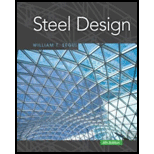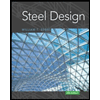
Steel Design (Activate Learning with these NEW titles from Engineering!)
6th Edition
ISBN: 9781337094740
Author: Segui, William T.
Publisher: Cengage Learning
expand_more
expand_more
format_list_bulleted
Question
Chapter 7, Problem 7.9.3P
To determine
(a)
The number of bolts using Load and Resistance Factor Design (LRFD).
To determine
(b)
The number of bolts using Allowed Strength Design (ASD).
Expert Solution & Answer
Want to see the full answer?
Check out a sample textbook solution
Students have asked these similar questions
Should public agencies be required to hire independent schedulers to evaluate delay claims when liquidated damages are significant?
Are liquidated damages provisions fair? Should every type of excusable delay be included in a construction contract?
Should contractors be allowed relief from the obligation of performance once such performance would become impractical due to the extreme expense the contractor would incur based on expenses not originally contemplated at the time of the contract?
Chapter 7 Solutions
Steel Design (Activate Learning with these NEW titles from Engineering!)
Ch. 7 - Prob. 7.3.1PCh. 7 - Prob. 7.3.2PCh. 7 - Prob. 7.4.1PCh. 7 - Prob. 7.4.2PCh. 7 - Prob. 7.4.3PCh. 7 - Prob. 7.4.4PCh. 7 - Prob. 7.4.5PCh. 7 - Prob. 7.4.6PCh. 7 - Prob. 7.6.1PCh. 7 - Prob. 7.6.2P
Ch. 7 - Prob. 7.6.3PCh. 7 - Prob. 7.6.4PCh. 7 - Prob. 7.6.5PCh. 7 - Prob. 7.6.6PCh. 7 - Prob. 7.7.1PCh. 7 - Prob. 7.7.2PCh. 7 - Prob. 7.7.3PCh. 7 - Prob. 7.8.1PCh. 7 - Determine the adequacy of the hanger connection in...Ch. 7 - Prob. 7.9.1PCh. 7 - Prob. 7.9.2PCh. 7 - Prob. 7.9.3PCh. 7 - Prob. 7.9.4PCh. 7 - Prob. 7.9.5PCh. 7 - Prob. 7.11.1PCh. 7 - Prob. 7.11.2PCh. 7 - Prob. 7.11.3PCh. 7 - Prob. 7.11.4PCh. 7 - Prob. 7.11.5PCh. 7 - Prob. 7.11.6PCh. 7 - Prob. 7.11.7PCh. 7 - Prob. 7.11.8PCh. 7 - Prob. 7.11.9PCh. 7 - Prob. 7.11.10P
Knowledge Booster
Similar questions
- Project Title: “City in Transition: A Public Policy and Planning Analysis” Detiot a city that is facing or has faced major urban development challenges. Using tools of planning analysis, urban policy evaluation, and public administration theory, you will analyze the city's development trajectory and propose actionable policy recommendations. 1. City Selection & Background - Briefly describe your chosen city: location, population, key demographics. - Provide historical context: major development periods, crises, or shifts. - Introduce key planning or equity challenges it has faced. 2. Key Issue(s) Analysis • Affordable Housing • Gentrification & Displacement • Zoning & Land Use Planning • Public-Private Partnerships • Redlining & Racial Segregation • rridors 3. Policy Evaluation - Choose one local or state policy and evaluate its impact—did it succeed or fail? - Use evidence and outcomes to support your critique. 4. Your Policy Recommendations -…arrow_forwardassume own values as needed. just need to see the processarrow_forwardHow can cities create policies that balance growth with protecting long-term residents and local businesses? Offer one concrete policy idea you would explore if you had the power.arrow_forward
- Determine the flow rate of the system shown in Figure. Consider that: D1 = D2 = 20 cm Roughness of D1 = 0.046 mm Roughness of D2 = 0.03 mm Length D1 = 20 cm Length D2 = 15 cm ΔA-B = 30 cm Pressure height at B = 5 cm Kinematic viscosity of 1.31x10^-6 m^2/sarrow_forwardA tank A supplies water to tanks B and C, but flow into and out of tank C is only possible when the valve is open. The pipe used throughout the system is made of a rough material with a roughness ɛ = 0.1 mm. The pipe lengths and diameters are: D1=75 mm, L1=150 m; D2=50 mm, L2=65 m; D3=75 mm, L3=53 m. For the data provided, determine: a)When the valve is closed, find the flow rate through the system if you know that the friction factor in the pipe is constant and corresponds to that of a rough pipe and the tank levels are Za = 15 m and Zb = 5 m. Consider the singular losses of the inlet, outlet and elbows that the system has (Ke = 0.5; Ks = 0.3; K elbow = 0.4) Suppose the valve is opened and the same flow continues to pass through the system from tank A as in the previous question, determine the height at which the water level will reach in tanks Zb and Zc and how the flow will be distributed through each branch (ignoring singular lossesarrow_forwardA tank A supplies water to tanks B and C, but flow into and out of tank C is only possible when the valve is open. The pipe used throughout the system is made of a rough material with a roughness ɛ = 0.1 mm. The pipe lengths and diameters are: D1=75 mm, L1=150 m; D2=50 mm, L2=65 m; D3=75 mm, L3=53 m. For the data provided, determine: When the valve is closed, find the flow rate through the system if you know that the friction factor in the pipe is constant and corresponds to that of a rough pipe and the tank levels are Za = 15 m and Zb = 5 m. Consider the singular losses of the inlet, outlet and elbows that the system has (Ke = 0.5; Ks = 0.3; Kelbow = 0.4) Draw the energy line and the piezometric line from the previous problemarrow_forward
- A reservoir supplies water to reservoirs B and C, but in C it is only possible when the valve is open. This action causes a decrease in flow rate in reservoir B, so as an expert in the field, you are asked to calculate the decrease in flow rate in reservoir B after opening the valve. Assume that the diameter and friction coefficient are constant throughout the system, with values of 0.2 m and 0.02 m, respectively. Ignore individual losses. Data: L1 = 80 m; L2 = 40 m; L3 = 75 marrow_forwardA tank A supplies water to tanks B and C, but flow into and out of tank C is only possible when the valve is open. The pipe used throughout the system is made of a rough material with a roughness ɛ = 0.1 mm. The pipe lengths and diameters are: D1=75 mm, L1=150 m; D2=50 mm, L2=65 m; D3=75 mm, L3=53 m. For the data provided, determine: Suppose pond C receives water from another source and this causes its level to rise to Zc=15m. Determine the singular loss coefficient Kvalve associated with the valve so that pond B receives the same proportions of flow from A as from C. Assume the valve is located right at the intersection and that the elevations of ponds A and B are Za=15m; Zb=5m, neglecting other singular losses.arrow_forwardA tank A supplies water to tanks B and C, but flow into and out of tank C is only possible when the valve is open. The pipe used throughout the system is made of a rough material with a roughness ɛ = 0.1 mm. The pipe lengths and diameters are: D1=75 mm, L1=150 m; D2=50 mm, L2=65 m; D3=75 mm, L3=53 m. For the data provided, determine: suppose that the level of each tank is controlled such that Za=15 m; Zb=5 m; Zc=5 m; Determine the flow rate through each pipe in the system, neglecting individual losses.arrow_forward
- Water at 10° C (v = 1.307 x 10^-6 m^2/s) flows from a tank A to B, through a cast iron pipe (ɛ = 0.26 mm) 20 m long and with a flow rate of Q = 0.0020 m3/s as shown in the figure. The system has 6 90° elbows (KL = 1.5) and the singular loss coefficient at the inlet KLentration = 0.5 and at the outlet KLoutlet = 1. Determine the necessary diameter for the system pipe.arrow_forwardA tank A supplies water to tanks B and C, but flow into and out of tank C is only possible when the valve is open. The pipe used throughout the system is made of a rough material with a roughness ɛ = 0.1 mm. The pipe lengths and diameters are: D1=75 mm, L1=150 m; D2=50 mm, L2=65 m; D3=75 mm, L3=53 m. For the data provided, determine: The valve is closed again, and the level in tank A rises to Za = 35 m, while tank B remains the same, Zb = 5 m. The new flow rate through the pipe is required, but in this case, the pipe's friction factor (f) is unknown. Ignore any special losses.arrow_forward1.- Calculate the regular head loss in a pipe with a diameter of 0.1 m and a length of 500m, in which a flow rate of 0.36 m^3/sec circulates. μ: 0.001 Pa*s.arrow_forward
arrow_back_ios
SEE MORE QUESTIONS
arrow_forward_ios
Recommended textbooks for you
 Steel Design (Activate Learning with these NEW ti...Civil EngineeringISBN:9781337094740Author:Segui, William T.Publisher:Cengage Learning
Steel Design (Activate Learning with these NEW ti...Civil EngineeringISBN:9781337094740Author:Segui, William T.Publisher:Cengage Learning

Steel Design (Activate Learning with these NEW ti...
Civil Engineering
ISBN:9781337094740
Author:Segui, William T.
Publisher:Cengage Learning